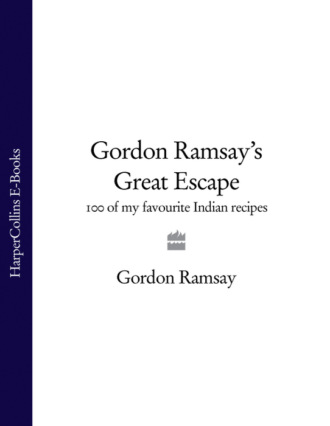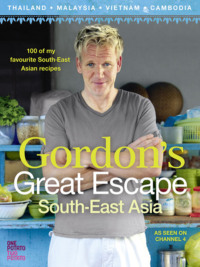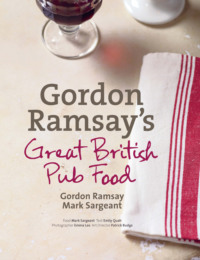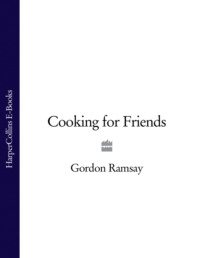
Полная версия
Gordon Ramsay’s Great Escape: 100 of my favourite Indian recipes

Gordon Ramsay’s Great Escape
Food Mark Sargeant Text Emily Quah

Table of Contents
Cover Page
Title Page
Introduction
Glossary
Starters & Snacks
Fish
Poultry & Meat
Vegetarian
Breads & Rice
Chutneys & Accompaniments
Sweets & Drinks
Index
Acknowledgements
Cook’ Note
Copyright
About the Publisher
Introduction
Over 3.5 million curries are eaten in the UK each year, which shows how much Indian cuisine is now part and parcel of the British diet. My own love affair with Indian food started when my mother made me my first curry as a child. Granted, mum’s inauthentic curries were nothing like what we’re used to today – hers were mostly flavoured with curry powder with the occasional handful of sultanas thrown in – but to us the flavours seemed exotic and mesmerising and I was hooked.
Since I left home and started working, Friday-night curries have become a ritual. Like most people, I have had favourite dishes, which I would order time and again, but overall I felt pretty comfortable with the food and thought that I knew quite a bit about Indian cuisine. How wrong I was! I had never been to India before this trip, and what little I knew about the country and its food was based on general stereotypes and preconceptions. I now realise that it is impossible to summarise the food of a vast subcontinent where differing cultures, religion, topography, climate and history all influence what food is eaten and how it is cooked.
When the opportunity came for a culinary adventure in India, the choice was simple. This was the chance of a lifetime to escape from the grind of daily life and discover the truth about Indian cuisine. I knew that real Indian food was not to be found in fancy restaurants and hotel eateries; instead I had to travel the country and eat as ordinary Indians do, regardless of caste, class or religious differences.
My journey started in the north, in the capital of New Delhi, home to 17 million residents. As I entered the city the first thing that struck me was the sheer contrast of wealth and severe poverty that was apparent everywhere, but I soon noticed that no matter what the individual situation was, almost everyone had a beaming smile. The Delhi residents also seemed to be working constantly, day and night; however, amid the hustle and bustle, I got a real sense of organised chaos that I had never experienced anywhere else before. In fact, this was the feeling I got in almost every Indian city to which I travelled, but Old Delhi was certainly a culture shock. The sights at the Red Fort were wonderful, and there were beautiful temples everywhere you looked, but, in the middle of it all, I was amazed to see rows of fragile-looking shacks that sold everything from mobile phones and shoes to food and Honda motorbikes!
Navigating and crossing the streets of Delhi proved to be a big challenge. The roads were filled with maniacs who drove wherever they chose with utter disregard for any street signs, regulations or pedestrians! There was a constant echo of horns beeping the whole time as every driver felt that he had the right of way. For me, the most amusing sight had to be the occasional herd of cows meandering along the streets, oblivious to oncoming traffic, while taxis, cars, motorbikes and tuk tuks did their best to avoid hitting the sacred animals.
Where food was concerned, my most memorable meal in Delhi was at the legendary Moti Mahal restaurant in Daryaganj, where classics such as tandoori chicken and butter chicken (one of my all-time favourites) were invented over 60 years ago. It was here that I met Seema Chandra, a renowned food writer and critic, who explained to me that the food in India is truly different from the Indian food that you get in Britain. This was clearly evident in the dishes at Moti Mahal: the delicious butter chicken was very moist, tender and flavour-some – unlike anything I’ve ever tasted. According to Seema, real Indian food is found on the streets and in family homes. Indians have not historically had a big restaurant culture, although this has now changed, and (for those who can afford it) eating out has become a popular pastime. Many homes have servants or mothers and grandmothers who prepare fresh, delicious meals for the entire family three times a day. Workers who do not have time to go home for lunch pick up cheap, delicious street food to sustain them until they can get home for dinner; children bring their lunches to school carefully packed in multi-tiered tiffin carriers, and shoppers indulge in street snacks before going home for their main meals. This emphasis on traditional home cooking means that recipes have been passed down from generation to generation and have seldom been well recorded, so if I wanted to get a true flavour of Indian cookery, I needed to roll up my sleeves and get my hands dirty.
One of the first things I learnt was that food is very important in India. Even the very poor will find a way to eat well with cheap but delicious meals. I understood this on board the Mangalore Express, on my way to Lucknow, the foremost city of food and culture. To earn my fare I was given an apron and immediately set on the task of prepping vegetables in the train cafeteria. There, a team of five chefs and 20 waiters make and serve fresh meals to over 400 passengers each day. For an equivalent of £110 a month, the chefs work 10 hours a day, 6 days a week in the most challenging of work environments. Pots constantly rattled and the portable stove shifted with the movements of the train. Nonetheless, they took great care to produce
hot, tasty and satisfying meals for the masses – a far cry from the pitiful, factory-made train food we have in the UK.
Lucknow was another revelation in terms of food. The city is famous for its exquisite cuisine and it is known as the birthplace of the korma and biryani. The original korma is a totally different dish from the British version, made lighter with yoghurt instead of cream and thickened with a paste made from ground almonds instead of coconut milk. The resulting dish was absolutely delicious, but it was a dark brownish-red colour instead of the creamy yellow to which we are accustomed. More remarkable were the biryanis, served at every festival and celebration. I had the privilege of spending a day with master chef, Imtiaz Qureshi, who in his heyday had catered for over 50,000 guests for a single event. We cooked dum ba biryani, a complex dish sophisticated enough to serve emperors and maharajahs. Similar in concept to a three-bird roast, this dish entailed two whole goats, four chickens and four quails stuffed with saffron-marinated quails’ eggs. The stuffed goats were then placed on a bed of biryani rice and meatballs, and the cooking pot was sealed with pastry to capture the aromatic flavours of the dish as it was finished off. A truly amazing biryani that you are unlikely to find in any cookery book (so I just had to include it in this one, see page 179)!
After experiencing the rich and indulgent food of the north, I went in search of back-to-basics cooking, and in unfamiliar territories. My travels took me to the poor, remote district of Bastar in the central state of Chhattisgarh. Here the local speciality is chakra, a delicious hot and tangy chutney made with chopped red chillies, salt, ground fresh ginger and a secret key ingredient: local ants! For obvious reasons I haven’t included the recipe in this book, but the local tribe has taught me what it really means to live off the resources of the land. Every single ingredient is sourced locally, and with the lack of refrigeration there is a strong emphasis on fresh produce.
This simple and honest approach to food was echoed in Nagaland and Assam, two of the Seven Sister States I visited in the remote northeastern corner of India. Dried spices, so ubiquitous in mainstream Indian cooking, are virtually absent from recipes there; instead, fresh chillies, ginger and garlic are the predominant flavourings. Meat and fish are hunted and cooked on the bone, resulting in very little wastage, and every part of an animal is eaten. I was also intrigued by the prevalent use of bamboo shoots in Nagaland, both in the fresh, smoked and dried forms, which link the cuisine to those of neighbouring China and Myanmar. Naturally, rice is the staple food of the region, and it comes in various forms. A local favourite is glutinous rice roasted in segments of fresh bamboo over an open fire. Talk about low-impact eco-cooking!
Next, my travels took me to the coastal areas of Kerala. With its beautiful and lush waterways, it is a much calmer and more relaxed part of India – exactly what I needed after an exhausting couple of weeks criss-crossing the country. Naturally, rice and fish are their staples, but as there is a sizeable Syrian Christian population in the area, pork and beef were also back on the menu. The food is lighter, as coconut milk is used in place of butter and cream, and more fragrant with the liberal use of spices and fresh curry leaves. One of the tastiest dishes I tried was karimeen pollichathu (see page 70). Karimeen is a much loved local freshwater fish, dubbed the ‘Fish of Kerala’, and in this dish it is smothered with a spice paste and roasted in banana leaves. The fish had a sublime flavour that reminded me of a sweet Dover sole; it is a real shame we can’t get it in England.
No trip to Kerala is complete without a visit to a spice market, and I was extremely impressed with the multi-coloured markets of Cochin. The image of giant piles of ginger, turmeric, cinnamon, cardamom and saffron (as well as the intoxicating fragrance) will always be embedded
in my memory. Standing in the middle of the market was a defining moment for me, it was then that I realised that one of the most important things to learn about Indian cooking is the delicate art of spicing. Although the use of various spices differs according to the region, religious beliefs or simply personal preference, the creative use of spice is what binds all Indian food together. Indian dishes may not always blow your head off in terms of heat (although many will), but they will always be fragrant and flavourful. The secret is in understanding how to draw out the natural flavours of a spice or change its characteristic and basic flavour profile – either through frying in oil, dry roasting or grinding – and using it to enhance the central ingredients of a dish. Spice combinations cannot be taught; you have to taste and experiment as you go along and learn from trial and error.
My culinary adventure ended in Mumbai (formerly known as Bombay), the capital of India. The city is such a key economic and cultural hub that nearly 200 different languages or dialects are spoken throughout the metropolis. At first glance it was disheartening to see the vast, seemingly never-ending stretches of slums surrounding the city. (Apparently, 55 per cent of the city’s population lives in shanty-towns or slums.) On closer inspection, however, it was amazing to see a thriving community working and living within the buildings with their corrugated-iron roofs. I spent a day in the Dharavi slum, home to more than a million people, learning how to make sambar from an enterprising chef and caterer aptly called Sambar Mani. Sambar is a classic lentil and vegetable dish that is delicious, light and nourishing (see page 213). It is one of the most loved vegetarian dishes in South India, and it is eaten with either plain rice or steamed fermented rice cakes called idli. I was truly impressed with the care and attention to detail that went into making the sambar. Most importantly, the dish tasted fantastic (even to a die-hard carnivore like myself) and is far superior to any vegetarian food we have in Britain. My wife, Tana, has been trying to get the family to have a meat-free day once a week, and with food like this I’m sure she would come up with little resistance.
My final challenge, the culmination of this whole trip, was to cook a southern Indian feast for 25 high-society guests at the Taj Mahal Palace Hotel in Mumbai. As many people will remember, the hotel was badly bombed and attacked by terrorists in 2008. It was amazing to see how they have bounced back after such a terrible show of aggression, and what I found there was a passionate and thriving business. I decided to cook a trio of karimeen dishes for the main course. (One of the benefits of doing a television programme is that I had the luxury of being able to have fish flown in from Kerala.) The dishes were made with Indian spicing, of course, but with slight European twists in the cooking methods. I was glad that the guests loved the food, but on a personal level I felt that I had come full circle.
I may not have covered every classic dish of every region during my relatively short culinary tour (indeed this book contains some recipes that were simply inspired by my travels and some of these classic dishes), but the knowledge that I have gained from the trip is immense. I am truly grateful to all those people who entertained, inspired and put up with me during what was, I can safely say, the most exciting thing I have ever done. India is a place of passion – both for food and for life. The cuisine is reflective of the people and culture, which is wonderful, vibrant and multi-faceted. I will never forget my time in this incredible country, and I can’t wait to return.
Glossary
Ajwain – Also known as carom seeds, ajwain resemble small cumin seeds but they have a strong fragrance of thyme and a slightly bitter and pungent flavour. They are always roasted in the oven or fried in oil or butter in Indian cooking.
Amchur/Amchoor – Green mango powder made by grinding pitted unripe mangoes that have been left to dry out in the sun. It has a greyish colour and a distinctive tart flavour, hence its use as a souring agent for food. It does not require cooking but may be added to dishes or sprinkled over snacks in place of lemon juice or vinegar.
Asafoetida (Hing/Heeng in Hindi) – A spice made from the resinous gum of the Ferula assafoetida plant. Mostly sold in powdered form, asafoetida is used in tiny quantities as a digestive aid to fight off indigestion and flatulence. It is often added to dishes at the beginning of the cooking process to be cooked out with other spices. Raw asafoetida has a very pungent, rather disagreeable odour that seems to disappear once cooked to leave a mellow, slightly sweet tang that is similar to that of roasted onions and garlic. Because it is not widely sold in supermarkets and you would only use a pinch in any dish, I have made it optional in the recipes here.
Atta/Chapatti flour – A wholewheat flour rich in fibre and protein that is used to make many classic unleavened Indian breads, such as chapatti and paratha. It can be bought from specialist Indian shops and some major supermarkets. If you can’t find it, use equal quantities of wholemeal and plain flours.
Chaat masala – A dry spice blend with a distinctive sour flavour that is mostly used as a condiment. It is often sprinkled over Indian snacks, raw fruit salads and tandoori dishes, and it can also be used to ‘liven’ up fruit juices. The specific blend of spices may vary according to the brand (or individual tastes) but chaat masala usually consists of dried mango powder, dried ginger, black salt, ground dried mint and asafoetida. Ready-made packets are widely available at Asian grocers.
Chai – A generic Hindi word for tea, but outside of India chai is commonly used to imply masala chai, a popular Indian-spiced milk tea.
Channa dal – Also known as cholar dal in Bengali, these are skinned and split black gram – they look and taste similar to yellow split peas, but the grains are marginally smaller. They have an earthy and nutty flavour. If you can’t get hold of them, use yellow split peas instead.
Coconut oil – An oil used commonly in southern Indian cooking that has been extracted from coconuts by a process of distillation. It is white in colour when solid but becomes transparent when heated. It has a high burning point, which makes it suitable for frying foods. It is high in saturated fats, and so for health reasons some people prefer to substitute it with other vegetable oils.
Garam masala – An aromatic spice blend that is used both during the cooking process, for a subtle fragrance, and as a garnish, where it is lightly sprinkled over a finished dish to give an added burst of aroma and flavour. Garam means ‘warming’ or ‘hot’ and the blend commonly includes cardamom seeds, cumin or black cumin seeds, nutmeg, black peppercorns, cloves and cinnamon, coriander and fennel seeds, although recipes vary significantly from region to region. Ready-made garam masala is easily found in supermarkets and Asian shops, but some brands tend to bulk up the ingredients with cheaper spices such as ground cumin and coriander.
Ghee – This is essentially clarified butter, which features heavily in northern Indian cooking. You can buy it ready-made in tins at Asian grocers, but I find these have a strong, overpowering aroma. To clarify butter, melt it gently, then pour off the oil through a muslin-lined sieve and discard the milky solids. For health reasons, many Indians now mainly cook with vegetable oil, but they will add a little unsalted butter or ghee to flavour and enrich a dish.
Gram flour – Also known as besan, this is made from finely ground chickpeas or channa dal. It is used in Indian cooking for a variety of purposes, such as soups and curries, and it is an integral part of the batter for bhajis and pakoras.
Grated coconut – Freshly grated coconut is often called for in Indian cooking. To extract the flesh from a coconut, crack it with the back of a strong cleaver or using a hammer. Drain off the coconut water (or save to drink later). You should have two halves of the coconut. Prise out the white flesh with a strong spoon then finely shred or grate using a food processor. Grated coconut can be frozen successfully for at least a month.
Jaggery – An unrefined natural sugar made from the concentrated sap of the date palm. It lends a distinctive sweet taste to both sweet and savoury dishes. Usually sold in solid blocks, jaggery is often grated before it is incorporated into dishes. The darker the colour of the jaggery, the stronger the flavour. You can substitute it with palm sugar or light brown soft sugar.
Kalonji – Also known as nigella seeds, these are black onion seeds with a teardrop shape. Kalonji is frequently used in pickles, chutneys and fish dishes as well as sprinkled on to Indian flat breads.
Karahi – A large, all-purpose rounded pan that is an essential piece of equipment in an Indian kitchen. It is particularly useful for deep-frying as it allows you to use less oil than you would when using a regular saucepan. If you do not already own a karahi, a wok makes a very good substitute.
Mustard oil – The oil extracted from mustard seeds, this has a pungent and slightly bitter taste when raw. Once heated, it develops a distinctive sweet flavour. An acquired taste, it is most commonly used in Bengali cooking for pickling and cooking fish and vegetables. If you can’t find it, substitute it with vegetable or groundnut oil.
Panch phoran – A Bengali spice blend made up of equal quantities of whole fennel seeds, fenugreek seeds, black mustard seeds, cumin seeds and nigella or black onion seeds.
Paneer – This fresh, unsalted curd cheese is widely used in both sweet and savoury Indian dishes. Paneer is very easy to make, requiring only whole milk and either lemon juice or vinegar. The milk is heated almost to boiling point, then removed from the heat and a little lemon juice or vinegar is stirred in. The milk will curdle or separate, and at this point the liquid is strained and hung for a few hours to remove the watery whey, leaving behind the fresh curd. Paneer is best made on the day it is to be eaten.
Rosewater – Made from distilled rose petals, rosewater is produced as a by-product of the process used to make rose oil. The widespread use of rosewater in Indian cooking comes from Persian influence; it is commonly sprinkled over biryani or pilau rice to lend a perfumed aroma to the dish.
Tamarind – Used as a souring agent in Indian cooking, particularly in the south, tamarind pulp is usually sold in blocks. To get tamarind purée, soak the tamarind pulp in water (roughly double the volume of water to weight of pulp) for at least 30 minutes. You should break the tamarind block up with your hands to achieve maximum flavour before straining the purée through a sieve and discarding the husks. More convenient but less flavour-some ready-made tamarind paste is now widely sold in jars in major supermarkets.
Tuvar dal – Dark ochre-coloured split and skinned pigeon pea lentils with a mild nutty and earthy flavour. These versatile lentils are very popular in Indian cooking and are a good source of protein and fibre.
Urad dal – Black gram usually sold split and skinned to reveal the yellow lentils inside. Urad dal is ground with rice to make the classic southern Indian dosa. It is also often fried in small quantities to give a nutty crunch to vegetable or rice dishes.
Конец ознакомительного фрагмента.
Текст предоставлен ООО «ЛитРес».
Прочитайте эту книгу целиком, купив полную легальную версию на ЛитРес.
Безопасно оплатить книгу можно банковской картой Visa, MasterCard, Maestro, со счета мобильного телефона, с платежного терминала, в салоне МТС или Связной, через PayPal, WebMoney, Яндекс.Деньги, QIWI Кошелек, бонусными картами или другим удобным Вам способом.










